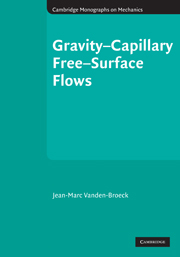3653 results in ebooks in fluid mechanics
Chapter Fourteen - Miscellaneous Weighted Residual Methods
- from Part Three - Finite Element Methods
-
- Book:
- Computational Fluid Dynamics
- Published online:
- 05 June 2012
- Print publication:
- 27 September 2010, pp 472-500
-
- Chapter
- Export citation
Chapter Three - Derivation of Finite Difference Equations
- from Part Two - Finite Difference Methods
-
- Book:
- Computational Fluid Dynamics
- Published online:
- 05 June 2012
- Print publication:
- 27 September 2010, pp 45-62
-
- Chapter
- Export citation
Preface to the Revised Second Edition
-
- Book:
- Computational Fluid Dynamics
- Published online:
- 05 June 2012
- Print publication:
- 27 September 2010, pp xxii-xxii
-
- Chapter
- Export citation
Frontmatter
-
- Book:
- Computational Fluid Dynamics
- Published online:
- 05 June 2012
- Print publication:
- 27 September 2010, pp i-iv
-
- Chapter
- Export citation
Chapter Four - Solution Methods of Finite Difference Equations
- from Part Two - Finite Difference Methods
-
- Book:
- Computational Fluid Dynamics
- Published online:
- 05 June 2012
- Print publication:
- 27 September 2010, pp 63-105
-
- Chapter
- Export citation
Chapter Two - Governing Equations
- from Part One - Preliminaries
-
- Book:
- Computational Fluid Dynamics
- Published online:
- 05 June 2012
- Print publication:
- 27 September 2010, pp 29-42
-
- Chapter
- Export citation
Chapter Sixteen - Relationships Between Finite Differences and Finite Elements and Other Methods
- from Part Three - Finite Element Methods
-
- Book:
- Computational Fluid Dynamics
- Published online:
- 05 June 2012
- Print publication:
- 27 September 2010, pp 519-540
-
- Chapter
- Export citation
Chapter Twelve - Incompressible Viscous Flows via Finite Element Methods
- from Part Three - Finite Element Methods
-
- Book:
- Computational Fluid Dynamics
- Published online:
- 05 June 2012
- Print publication:
- 27 September 2010, pp 407-425
-
- Chapter
- Export citation
Chapter Eleven - Nonlinear Problems/Convection-Dominated Flows
- from Part Three - Finite Element Methods
-
- Book:
- Computational Fluid Dynamics
- Published online:
- 05 June 2012
- Print publication:
- 27 September 2010, pp 347-406
-
- Chapter
- Export citation
Chapter Twenty-Seven - Applications to Relativistic Astrophysical Flows
- from Part Five - Applications
-
- Book:
- Computational Fluid Dynamics
- Published online:
- 05 June 2012
- Print publication:
- 27 September 2010, pp 965-986
-
- Chapter
- Export citation
Chapter Thirteen - Compressible Flows via Finite Element Methods
- from Part Three - Finite Element Methods
-
- Book:
- Computational Fluid Dynamics
- Published online:
- 05 June 2012
- Print publication:
- 27 September 2010, pp 426-471
-
- Chapter
- Export citation
Preface to the First Edition
-
-
- Book:
- Computational Fluid Dynamics
- Published online:
- 05 June 2012
- Print publication:
- 27 September 2010, pp xix-xxi
-
- Chapter
- Export citation

Gravity–Capillary Free-Surface Flows
-
- Published online:
- 07 September 2010
- Print publication:
- 15 July 2010
6 - Wave propagation and spectra
-
- Book:
- Internal Gravity Waves
- Published online:
- 05 October 2014
- Print publication:
- 02 September 2010, pp 315-356
-
- Chapter
- Export citation
Preface
-
- Book:
- Internal Gravity Waves
- Published online:
- 05 October 2014
- Print publication:
- 02 September 2010, pp xiii-xvi
-
- Chapter
- Export citation
5 - Generation mechanisms
-
- Book:
- Internal Gravity Waves
- Published online:
- 05 October 2014
- Print publication:
- 02 September 2010, pp 262-314
-
- Chapter
- Export citation
1 - Stratified fluids and waves
-
- Book:
- Internal Gravity Waves
- Published online:
- 05 October 2014
- Print publication:
- 02 September 2010, pp 1-73
-
- Chapter
- Export citation
Contents
-
- Book:
- Internal Gravity Waves
- Published online:
- 05 October 2014
- Print publication:
- 02 September 2010, pp vii-xii
-
- Chapter
- Export citation
Dedication
-
- Book:
- Internal Gravity Waves
- Published online:
- 05 October 2014
- Print publication:
- 02 September 2010, pp v-vi
-
- Chapter
- Export citation
3 - Internal waves in uniformly stratified fluid
-
- Book:
- Internal Gravity Waves
- Published online:
- 05 October 2014
- Print publication:
- 02 September 2010, pp 141-212
-
- Chapter
- Export citation
